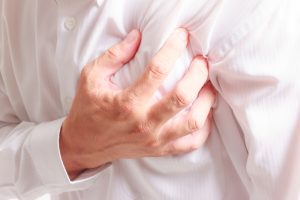 Left arm pain or shoulder pain can be a common symptom of an impending heart attack. A heart attack occurs when the blood flow to the heart is blocked as a result of plaque buildup along the arteries. When blood flow is interrupted, part of the heart muscle can get damaged and, depending on severity, can lead to death.
Left arm pain or shoulder pain can be a common symptom of an impending heart attack. A heart attack occurs when the blood flow to the heart is blocked as a result of plaque buildup along the arteries. When blood flow is interrupted, part of the heart muscle can get damaged and, depending on severity, can lead to death.
The good news is, the success rates of surviving a heart attack are much higher nowadays, but the key is recognizing the signs of a heart attack early on and seeking treatment right away.
Shoulder pain and its link to heart attack
Advertisement
Chest pain is one of the most common signs of a heart attack that many people recognize easily. But sometimes, there are other symptoms as well, which you may not associate with a heart event. Case in point, shoulder pain can be a sign of a heart attack.
The shoulder can begin to hurt as a result of the pain radiating from the chest. This is most commonly experienced on the left side where your heart resides.
It’s important to be aware of this type of pain as a symptom of a heart attack, as well as other strong and weak indicators of a heart attack. The below chart will help you distinguish between the two.
| Strong Indicators of a Heart Attack | Weak Indicators of a Heart Attack |
|---|---|
| Burning, squeezing, tightness, pressure, or pain sensation | Knifelike or sharp pain felt when coughing or sneezing |
| Gradual increase of pain over a few minutes | Pain concentrated on one point. |
| Pain in the diffuse area, including middle of the chest | Pain occurring distinctly on one side of the body |
| Pain extending to back, jaw, neck, and left arm | Abrupt stabbing pain that lasts for a very short moment |
| Pressure or pain accompanied by other symptoms like sudden nausea, cold sweat, problems breathing | Pain lasting for days or hours without any other symptoms |
| Pressure or pain that is felt during emotional stress or physical exertion or when you are resting (unstable angina) | Pain caused by pressing the chest or body movement |
Tips to determine if the left arm pain is heart related
Your left arm can hurt for a number of reasons including overstrain or even injury, so how can you tell when it is related to the heart? The below tips will help you distinguish regular left arm pain and heart-related left arm pain.
Evaluate the quality of your pain: Pain will feel like pressure or squeezing in the chest, and vary in intensity. If this pain then moves to the left arm, that indicates it is a heart-related left arm pain.
Look for non-pain-related symptoms: Left arm pain that exists on its own is rarely caused by the heart. Looking for other non-pain-related symptoms can help you better determine if you are about to have a heart attack. These symptoms include nausea, lightheadedness or dizziness, cold sweating, and shortness of breath or difficulty breathing. If these non-pain symptoms coexist with your pain, you need to contact a doctor immediately.
Evaluating your pain: When evaluating your pain, it’s important to first note the duration of the pain. If the pain only lasts for a few seconds, it is quite unlikely that it is caused by the heart. If pain is persistent, lasting days or weeks, that is also an unlikely indicator of heart-related pain. Pain related to a heart attack will last for a few minutes or hours, and it may also reoccur in short intervals. Lastly, if pain in the left arm occurs only when you use the arm for physical activity, it is due to muscle issues, not heart.
Left arm pain may also be related to angina, when there is a brief moment of insufficient blood flow to the heart. In angina, pain will worsen with physical or emotional stress. Although not life threatening like a heart attack, it’s still important to control your angina to reduce the risk of any complications.
Lastly, when evaluating your pain, it’s important to look for other signs and symptoms, including pain in the jaw, moving pain, heaviness or pressure pain, or dull back pain. In some cases, heart attacks may be silent, so no symptoms may be experienced.
Symptoms that should accompany left arm pain
 Chest pain: Chest pain is the most commonly recognized symptom indicating that there is something wrong with the heart. But for some patients, chest pain does not occur as a symptom of a heart attack. You may experience pressure, tightness, or pain originating in the center of the chest spreading down the arm, to the back, or to the neck and jaw (we will explain this symptom further down).
Chest pain: Chest pain is the most commonly recognized symptom indicating that there is something wrong with the heart. But for some patients, chest pain does not occur as a symptom of a heart attack. You may experience pressure, tightness, or pain originating in the center of the chest spreading down the arm, to the back, or to the neck and jaw (we will explain this symptom further down).
Unusual fatigue: We all get tired from time to time, but if fatigue is new, sudden, or dramatic, it could be a sign of a heart attack. This includes suddenly feeling worn out after your typical exercise routine, feeling fatigued even without physical exertion or after simple activities like making the bed, and experiencing sleep problems even though you feel exceptionally tired.
Sweating and/or shortness of breath: If you experience sudden sweating or shortness of breath without physical activity, breathlessness that worsens without activity, shortness of breath that worsens when lying down and improving when getting up, stress sweat with no apparent stress, or sweating or shortness of breath that is accompanied by the other symptoms listed here, then these are signs of a heart attack.
Neck, jaw, and head ache: As mentioned, chest pains can move to affect the neck or jaw, but pain in the jaw or neck can occur without the presence of chest pain during a heart attack.
Nausea: Women are more likely than men to report nausea as a symptom of a heart attack. It may also be accompanied by indigestion symptoms or frequent belching. Some patients have even described feeling as if they have a flu leading up to a heart attack. If nausea or indigestion is sudden with no apparent cause, this could be related to a heart attack.
Upper middle abdomen discomfort: In some patients, pain experienced in a heart attack may feel like upper middle abdomen pain. You may experience heaviness or a sharp pain that is temporary or persistent.
Heartburn: Once again, heartburn, or indigestion, can be a common symptom related to a heart attack. This is similar to upper middle abdomen discomfort.
Upper back pain: Pain from the chest may radiate to the upper back and can be experienced in-between the shoulder blades.
Lightheadedness: Women often report lightheadedness or dizziness more often than men when experiencing a heart attack. They may feel as if they are about to pass out and have difficulties exerting themselves or even moving.
Heart palpitations: The heart may feel as if it is skipping a beat, the rhythm has changed, or that the heart is pounding or throbbing.
Advertisement
Vomiting: After the feeling of indigestion or nausea, some patients may experience vomiting. If this is not caused by something you ate, it could be tied to an impending heart attack.
What to do when a heart attack occurs
If you believe a person is having a heart attack, have them sitting, keep them calm, loosen any tight clothing they may be wearing, have the person take any chest pain medications like nitroglycerin. If pain does not improve within three minutes of taking the medication, call emergency right away. Always call 911 immediately if a person is unconscious.
DO NOT leave the person, have them convince you not to call 911, wait to see if symptoms go away, give the person anything by mouth unless it is a prescribed medication.
